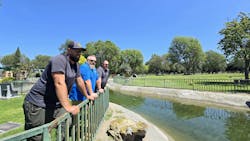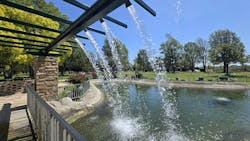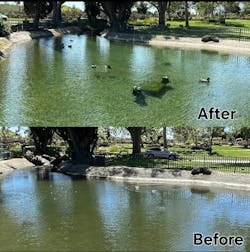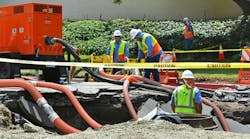Westminster Memorial Park: Stormwater lessons from a century-old landscape
Key Highlights
- The project involved rehabilitating existing wells, dredging the irrigation pond and installing biochar filters and ultrasonic algae disruptors to improve water quality and reliability.
- Modern irrigation was achieved by replacing outdated pumps with VFD-controlled systems, updating thousands of sprinkler heads and implementing smart controllers paired with soil-moisture sensors.
- Soil health was integrated into stormwater management, using data-driven watering practices to reduce runoff, support plant health and enhance infiltration across varied soil types.
A system outgrown by time
Westminster Memorial Park retrofit at-a-glance:
- 88 acres of irrigated landscape
- 4 wells (2 remediated, 1 in progress, 1 abandoned)
- 2-acre pond restored with biochar + ultrasonic buoy
- 75HP pump replaced with dual 40HP VFD skid
- 250+ valves, 1,000+ heads updated
- 41 smart controllers and 50 soil-moisture sensors
The roots of Westminster Memorial Park in Orange County, California, date back to 1924, when it was founded as Central Memorial Park. After the 1929 stock market crash forced the original investors out, new ownership in the 1930s redeveloped the site as a memorial park, later adding mausoleums, a mortuary and a landmark chapel.
Nearly a century later, the 150-acre property remains a memorial landscape and cultural hub. Its early 20th-century irrigation network, expanded through the decades, left the park with an aged, unreliable water supply, a sediment-clogged pond, and labor-intensive maintenance.
For a site with both historic significance and active community use, reliable water management was critical. The challenge was how to modernize the system without losing the park’s character or disrupting daily operations.
A century of wear
As an active cemetery approaching its centennial, Westminster Memorial Park faced water management challenges common to legacy landscapes. To address them, the park turned to The Davey Tree Expert Company and its technical services division, the Davey Institute.
Institute specialists began with a comprehensive site assessment, which included inspecting wells and the irrigation pond, reviewing pumps and wiring, zone configuration, assessing controls and sampling soils to understand infiltration across different areas and cultural practices used at the cemetery to maintain the system. The findings reflected nearly a hundred years of growth and continuous use.
Only one of the four original wells was still in service, leaving the park dependent on a single source. The irrigation pond had lost capacity to sediment and organic buildup, fueling algae growth. Nearly half the grounds required manual watering due to failed wiring and mismatched controls. Routine burials further disrupted the soil profile, creating uneven infiltration across the site.
“These weren’t signs of neglect,” explains Paul Kovacik, director of Water Management Services at the Davey Institute. “They were the realities of a site in constant use for a hundred years.”
With these findings in hand, Davey Institute specialists developed a plan to restore water reliability and improve stormwater performance.
These weren’t signs of neglect. They were the realities of a site in constant use for a hundred years.
- Paul Kovacik, director of water management services at the Davey Institute.
Restoring the water source
Five lessons for stormwater managers:
- Stabilize source water before upgrading distribution.
- Blend ecological tools (biochar, biological treatments) with smart technology.
- Understand soil health as part of stormwater infrastructure.
- Retrofit selectively — salvage where possible, replace where needed.
- Train staff and plan for long-term maintenance.
The first priority was stabilizing the water supply. One long-dormant well was rehabilitated and fitted with new pumps, restoring redundancy. Another was inspected and will be brought online to secure capacity for future expansion.
The two-acre irrigation pond, an essential reservoir, was dredged to remove accumulated sediment. Crews also installed bio-nests with biochar-filled socks to filter water and digest organic waste, while an ultrasonic buoy disrupted algae formation.
Together, these measures created a healthier water source for the entire system.
Modernizing the irrigation network
The irrigation system itself was equally transformed. The old 75HP pump, which ran continuously without controls, was replaced by a dual 40HP VFD-controlled skid. Nearly 250 valves and more than 1,000 sprinkler heads were replaced or repositioned for uniform coverage. Mixed zones were separated, and narrow planter beds were converted from spray to drip irrigation to prevent overspray on memorial stones.
Automation brought the most significant change with the installation of 41 smart controllers sitewide, paired with 50 soil-moisture sensors in key microclimates. Where staff once relied on visual cues and past practices, irrigation now responds directly to measured soil conditions.
Integrating soil health
Soil health became part of the stormwater solution, with infiltration ranging from fast-draining sandy areas to heavy clay prone to runoff, as well as burial activity adding further disruption.
By tying soil-moisture data into the irrigation network, the team could account for these variations. Water is now applied based on actual saturation, preventing runoff and protecting infiltration capacity. Healthier soil now reduces stormwater load while supporting turf and plantings.
Results seen above and below ground
Improvements were quickly visible. The irrigation pond, once cloudy and algae-prone, began to clear as sediment was removed and biological treatments took hold. The two rehabilitated wells provided additional water security, reducing the park’s reliance on a single source.
Operations also became more efficient. The new VFD-controlled pump system used less energy than the continuously running 75HP motor it replaced. Staff who had once spent hours manually opening valves were able to redirect their time toward maintaining the new systems, as well as turf and plantings.
Soil-moisture sensors and smart controllers began to show their impact, too. Areas that had once been prone to overwatering were stabilized, and turf established more consistently across different soil conditions. These improvements provide a more resilient setting for the many community events and ceremonies that take place throughout a typical year.
Lessons for legacy sites
“Technology is only part of the solution,” said Kovacik, “stewardship is what makes it last.” That perspective guided the Westminster project and offers lessons for other historic or complex landscapes:
- Stabilize sourcewater before upgrading distribution;
- Combine ecological tools such as biochar with modern controls;
- Treat soil health as core stormwater infrastructure and;
- Train staff to sustain long-term results.
Conclusion
Westminster Memorial Park’s irrigation and stormwater retrofit shows how legacy systems can be renewed without starting from scratch. By restoring wells, rehabilitating the pond, integrating biochar and biological treatments, modernizing irrigation and installing a uniform smart control system, the project created a more resilient landscape for both daily operations and community use. For other sites balancing historic infrastructure, ecological concerns, and high public visibility, Westminster demonstrates that blending technical upgrades with ecological practices can deliver lasting improvements in water quality, efficiency and stormwater performance.
About the Author
Jill Rebuck
Jill Rebuck is senior project manager of corporate communications at The Davey Tree Expert Company. She covers a wide range of topics, including environmental stewardship, water management, and infrastructure projects that connect science to sustainability.




